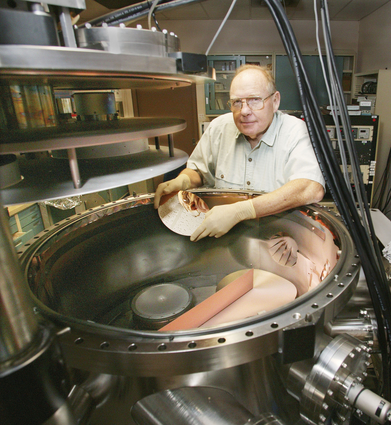Barbee wins NRL award for publication of white dwarf research
 (Download Image)
Troy Barbee holds one of the multilayer structures fabricated in a high vacuum magnetron sputter deposition apparatus. These wavelength reflecting optics and nanolaminate materials are used for the scientific study of new phenomena and the development of advanced materials. Photo by Jackie McBride/LLNL
(Download Image)
Troy Barbee holds one of the multilayer structures fabricated in a high vacuum magnetron sputter deposition apparatus. These wavelength reflecting optics and nanolaminate materials are used for the scientific study of new phenomena and the development of advanced materials. Photo by Jackie McBride/LLNL
The paper, which was the most recent paper stemming from a long history of collaboration between Barbee, researchers in the Naval Research Laboratory's (NRL) X-ray Astronomy Program and researchers from the University of Leicester, reports the first high-resolution spectroscopic observation of the binary DA white dwarf Feige 24 in the extreme-ultraviolent band.
Barbee of the Lab's Condensed Matter and Materials Division used the multilayer coated gratings, developed at the Laboratory, in the experiments. The findings show that helium is nearly completely lacking in Feige 24's makeup, a surprising result contrary to standard models of stellar atmosphere evolution.
The findings allowed scientists to gain new insight into stellar evolution by looking at the structure of Feige 24.
A white dwarf is a small star composed mostly of electron-degenerate matter. A white dwarf's mass is comparable to that of the sun and its volume is comparable to that of the Earth. White dwarfs are thought to be the final evolutionary state of all stars whose mass is not high enough to become a neutron star -- more than over 97 percent of the stars in the Milky Way.
White dwarfs get larger over galactic history so that their density reflects galactic maturity and their cooling encodes information on the history of star formation and age of the disk. As compact objects, they are the third element of a trio that includes neutron stars and black holes, which remains the central topic of astronomy in X-rays.
The team observed two white dwarfs at high resolution in the extreme-ultraviolet (EUV) and, despite the differences in the evolutionary paths, they obtained very similar results. They also determined that a pattern is beginning to emerge in the interstellar helium ionization fraction.
"It seems most likely that these stars are altering the immediate environment in some way, perhaps through a weak wind driven by their high temperature," Barbee said.
Barbee also has been a co-recipient of three R&D 100 awards and has earned more than 18 patents. He was elected to The Royal Academy of Arts and Sciences of Uppsala as a Foreign Member on May 14, 2000.
The NRL award, which recognizes the best publications from each division within NRL, will be presented at a reception and dinner on March 16 at the Joint Base Anacostia-Bolling in Washington, D.C.
Contact
Anne M Stark[email protected]
925-422-9799
Tags
Physical and Life SciencesFeatured Articles







